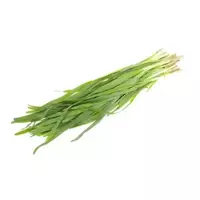Allspice jusai onions

Allspice jusai or jutsay onions belong to a species of perennial plants of the Onion family. The uniqueness of allspice jusai onions lies in the unique palette of plant tastes. Fragrant jusai onions have a combination of the taste of ordinary spring onions and garlic. Most often, green leaves of allspice onions are used in cooking, which give the final dish a distinctive garlic-onion taste and aroma.
The homeland of the onion of fragrant jusai is the mountainous regions of China, as well as Mongolia. Fragrant onions are believed to have been an essential ingredient in the cuisine of the region's nomadic peoples, who spread the plant throughout Asia. The main difference between juxai onions and other species lies in the growing conditions of the product. Fragrant onions need certain mild and warm climatic growing conditions. However, some subspecies of juxai onions can withstand even small sub-zero temperatures, so the plant can be found in our latitudes.
In appearance, fragrant onions are similar to spring onions, but there are also significant differences. For example, dark green leaves of juxai onions have a flat shape, a narrow-linear onion in diameter no more than
1. 5 cm. Juxai blooms in small purple inflorescences, which have a distinctive fragrant smell, which determines the name of the plant. Branched jusai onions have been cultivated for many centuries in order to use the unusual taste of the plant in cooking.
The original mixing of onion and garlic flavors is the main feature of jusai. The taste of fragrant onions can be described in a nutshell as follows - half-round and garlic. Allspice jusai onions are most popular in Southeast Asian countries, where this plant is used everywhere in almost all dishes of the national cuisine. Usually, green juxai leaves are eaten. However, in countries such as Thailand and China, they use undisclosed inflorescences and onion jusaya arrows.
Allspice jusai onions are great for fresh vegetable salads. Juxai is also added to meat and fish dishes, soups and snacks. In Kazakhstan, they make the original national salad from radish and onion of fragrant jusai. Jusai leaves are a must-have ingredient in an old Kazakh cold snack made from meat offal. Also, fragrant juxai onions are used in dishes made of boiled beef or lamb meat. Jusai is added to the mince for manta.
In Asia, jusai can be found in almost any dish. Most often, fragrant onions are added to noodles, vegetables and meat dishes. Jusai is an indispensable ingredient in most sauces served with meat and game dishes. Such a national delicacy of a number of states as lagman (noodles based on meat broth with pieces of lamb or beef) requires the obligatory presence of fragrant jusai among the components of onions. Without jus, the dish will not get its excellent taste and pronounced garlic-onion aroma.
onions of fragrant jusai 41 kKal
Energy value of allspice jusai onions (Ratio of proteins, fats, carbohydrates - ju):
Proteins: 1.4 g (~ 6 kCal)
Fats: 0.2 g (~ 2 kCal)
Carbohydrates: 8.2g (~ 33kCal)
Energy ratio (b | y): 14% | 4% | 80%
 Español
Español Français
Français Português
Português Русский
Русский 简体中文
简体中文 繁體中文
繁體中文 日本語
日本語 한국어
한국어 العربية
العربية Türkçe
Türkçe Қазақ
Қазақ Deutsch
Deutsch Italiano
Italiano Українська
Українська
